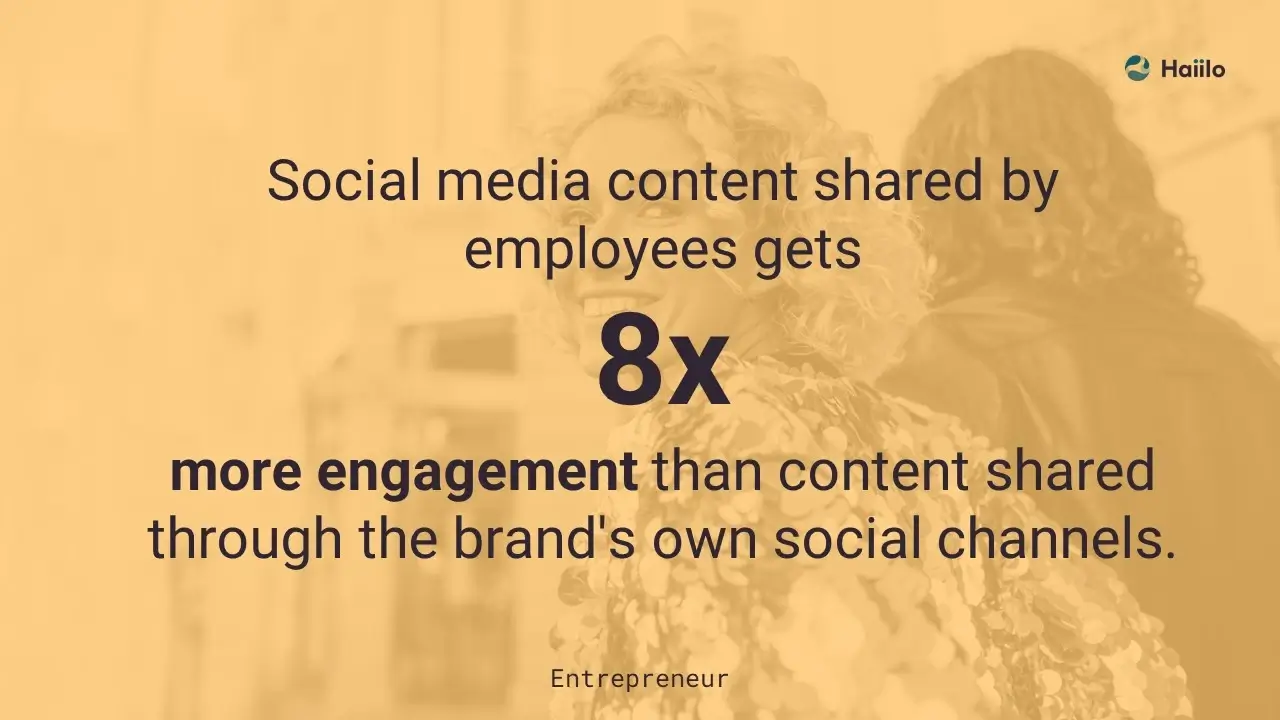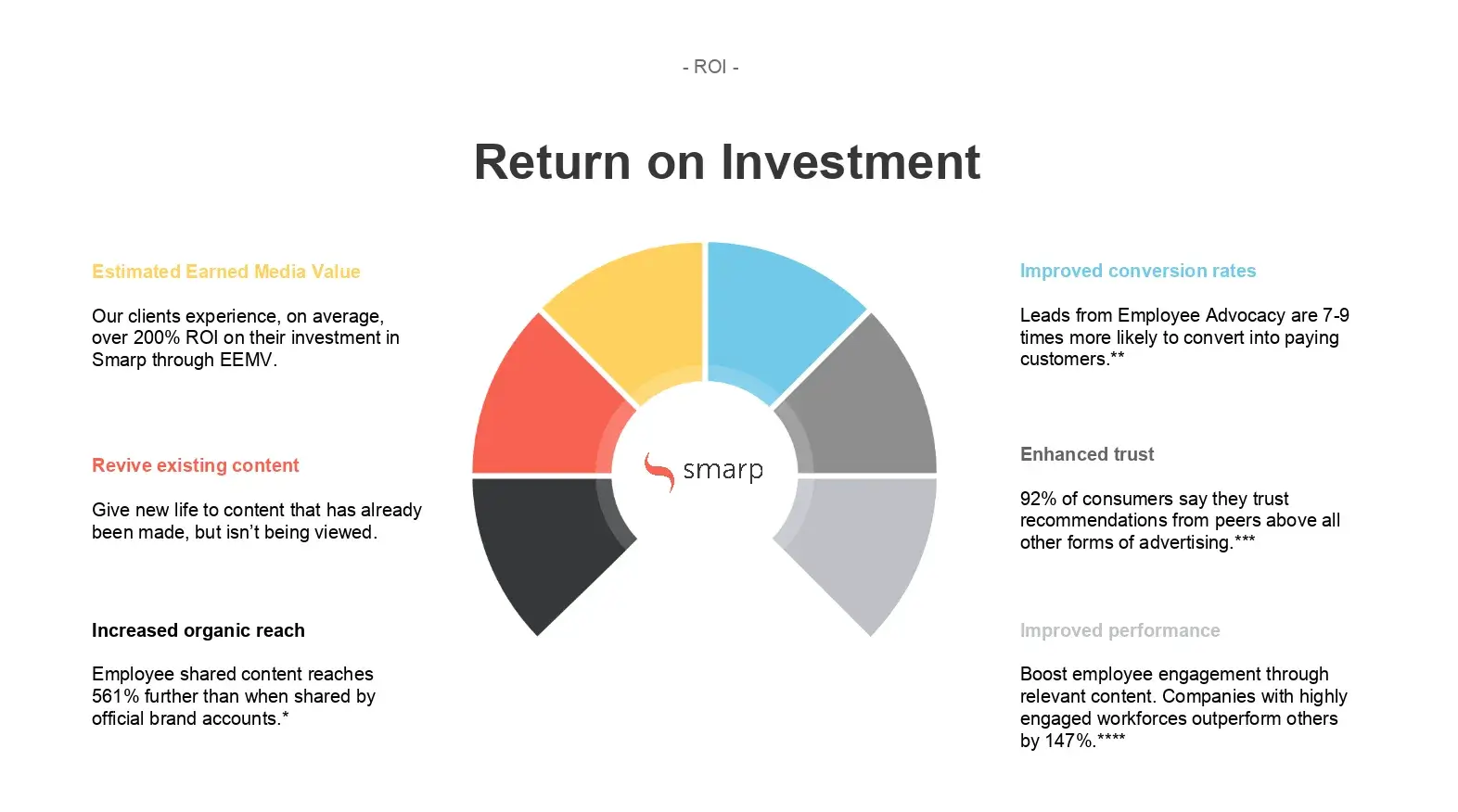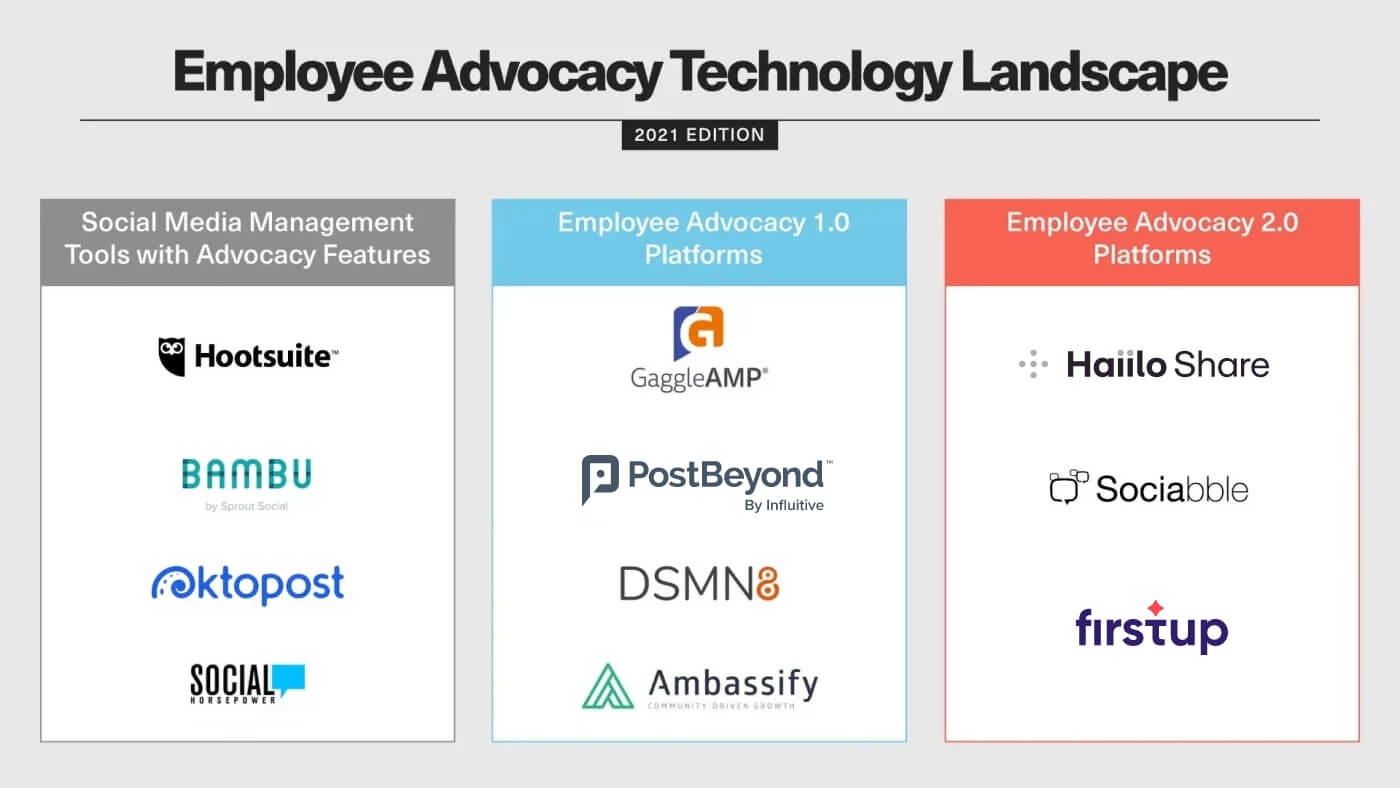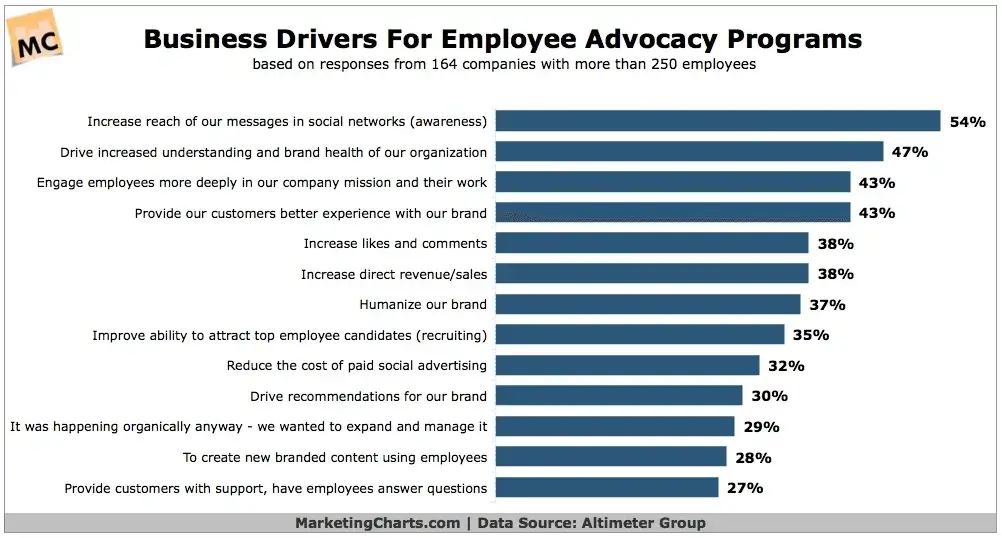You’re planning to launch an employee advocacy program on social media but you don’t know where to start? Don’t worry, we’ve compiled in this blog post key steps to make your program successful!
Employee advocacy is a powerful way to drive brand awareness, boost sales, build trust, and optimize employer branding initiatives.
For that reason, 90% of brands have plans to start an employee advocacy program or have already implemented a strategy to encourage employees to become brand ambassadors.

With the emergence of remote work and social distancing restrictions, people are using social media more than ever before. For that reason, employee advocacy on social media is becoming one of the most efficient ways to improve business performance.
What is Employee Advocacy?
In a nutshell, employee advocacy is the promotion of a company by its employees. By sharing company-related content such as company news or product updates, employees contribute to the company’s image and they significantly facilitate social recruiting efforts.
Employee advocacy is a great way to boost your brand image and recognition all while helping your employees build their thought leadership.
However, you can’t make your brand ambassadorship program successful without a concrete strategy. You need to craft a structured plan for your program and make sure that your employees are on board.
Get a demo now to see the benefits of an employee advocacy program for yourself
6 Steps to Implement a Successful Employee Advocacy Program
According to Entrepreneur, social media content shared by employees gets 8 times more engagement than content shared through the brand’s own social channels, and is shared 25 times more frequently.

However, building a successful employee advocacy program can be a tall order for organizations. However, there are certain steps that should be followed. Efficient change communication is one of the biggest prerequisites for driving employee engagement and leadership buy in.
If you manage to get your employees on board and help them understand the benefits of employee advocacy, they will be more likely to engage with the program and drive high ROI.
Here are key steps that will help you empower your employees to help you boost your social media strategy:
1. Identify Your Brand Ambassadors
Decide which employees are going to participate in your employee advocacy program beforehand.
You can either get started with a small group of users and scale up your program later on or you can invite all your employees to take part in the program right away.
Your strategy will depend on your company culture, size, and organizational structure. You may want to opt for the first option if your employees are not familiar yet with personal branding tactics.
Starting your employee advocacy program with a smaller group of users will help you educate the participants and rethink your program if needed.
However, employees who are not invited to join the program may feel excluded from your branding efforts which may affect employee engagement at your workplace.
By inviting all your employees to become brand ambassadors right away, you make employee advocacy a company-wide effort.
Activating all your employees not only does strengthen team cohesion in your organization, but it also helps you improve your brand’s reach and web traffic right away.
💡Whichever option you choose, make sure that team leaders are on board so they can share personal branding best practices with their team.
2. Set Specific and Measurable Goals
You need to set clear goals before you actually start your employee advocacy program.
What are your expectations, what KPIs do you want to look at to measure the success of your program? Do you want to empower your employees on social media to boost your content marketing strategy, increase traffic to your website, generate leads or do you expect your employees to contribute to your employer brand?

Setting specific goals beforehand will help you start your program in the right way and keep track of your progress. Make sure that the KPIs you choose are clear enough and relevant to your business.
Too many employee advocacy programs fail because of a lack of metrics.
Share your goals and KPIs with the whole organization so everyone is on the same page and able to evaluate the results achieved so far now.
💡Don’t forget your employees! Make sure that your program helps them build their personal brand and position themselves as experts in your industry. Define with your employees personal objectives they want to achieve by participating in the program.
3. Plan Your Content Strategy
Content is key when it comes to employee advocacy. Think about it: how can you expect your employees to share company-related content if this content is not engaging?
The key is to include in your program content that is relevant to your employees and their networks.
For example, you may want to share with your employees company news, product updates, but also tips and best practices.
Don’t forget to use in-house content but also third-party content that will sound less promotional. Indeed, Internet users tend to be fed up with corporate messaging: 83% of Internet users would like to be able to filter ads they see.
To make your employee advocacy program engaging, share with your employees blog posts, press releases, infographics and videos. According to G2Crowd, videos shared on social media generate 1200% more shares than text and image.
💡 Related: Tara Hunt on How to Build a Great YouTube Marketing Strategy
That’s not surprising that social media platforms keep updating their algorithms to push more videos into users’ news feeds. Remember what Mark Zuckerberg already said back in 2014:
“We see a world that is video first with video at the heart of all our apps and services.”
Use an employee advocacy platform to make it easy for employees to find the right content. Create channels that users can subscribe to to make sure they get content they are interested in. Give them the opportunity to like and comment content they find interesting.
Remember that you have to make it easy for your employees to find content related to the industry and their expertise so they can easily share it to their personal networks. Your content distribution is the key to driving adoption and engagement.
💡Did you know that your employees could contribute to your content strategy? Your employees are proud to be associated with your brand so give them the opportunity to share their own thoughts and experience, invite them to create their own posts!
4. Invest in a Proper Training Program
Some of your employees may not be familiar with personal branding tactics and others may be willing to share company-related content with their networks but may feel insecure about the information they actually can share.
To make the participation in the program easier for your employees, you may want to implement a structured and customized training program.
This step is critical when it comes to planning an employee advocacy strategy, it will help you overcome barriers that may hold back your employee advocacy program.
Be creative in your training plan: you can for example host webinars, workshops, grant access to online courses or even organize an off-site event for the official launch of the program.
The idea is to help your employees build their personal brand on social media. Think about it: if your employees position themselves as industry experts, they will be able to build brand trust in a successful way.
Your training program will depend on your company culture and, of course, your budget!
We recap in this infographic the golden rules of personal branding on social media:

💡Invite employees who are the most engaged in your program to host workshops. That way you show them that you trust them and value their expertise. After all, employee advocacy is a win-win relationship!
5. Ask for Feedback
Too many businesses forget to ask for feedback from their staff when it comes to employee advocacy while their help is essential to improve the program.
You build an employee advocacy program for but also with your employees so give them a voice!
You can ask feedback on several topics: the launch of the program, the content you curate for your employees, the training plan you have implemented, the way you gamify your program, or the way the goals have been communicated across the organization!
6. Implement the Right Technology
Planning, implementing, and managing a successful employee advocacy program is impossible without the right technology. Luckily, there are solutions designed to make advocacy marketing more efficient, streamlined, and easier for employees.
If you are considering implementing an employee advocacy program in your organization, consider ne of these 7 best employee advocacy solutions currently available on the market.

Business Drivers for Employee Advocacy Programs
As mentioned earlier, employee advocacy has many benefits. More specifically, it can impact the performance of your marketing, sales, and HR departments.
Engaging your employees in promoting your organizations content not only boosts marketing, sales, and employer branding, but it also encourages employees to create their own content and humanize your brand. Here are just a few statistics that prove that point:
- According to Fast Company, leads developed through employee social marketing convert 7 times more frequently than other leads.
- According to Hinge, 87% of employees recognized that employee advocacy contributed to expanding their professional network, and 76% believed that it helped them keep up with industry trends.
- According to LinkedIn research, companies whose employees share their brand’s social content see a lift in the views that their job postings receive.
- According to Kredible, on average, an employee advocacy program involving 1,000 active participants can generate $1,900,000 in advertising value.
Furthermore, it engages employees more deeply in your company mission and aligns employees with your core company values. The image below is the perfect representation of how employee advocacy can impact your overall business success.

The Do’s and Don’ts for Your Employee Advocacy Program
The Do’s of Employee Advocacy Programs:
- Set clear goals
- Select the KPIs you want to track before implementing your employee advocacy program
- Make sure everyone feels included in the program
- Communicate the goals to your employees
- Organize training sessions
- Use content that is relevant to your employees and their networks
- Include company-related content but also third-party content into your program
- Ask feedback from your employees
- Support your employees’ personal branding efforts
- Let employees create their own content
- Use your employee advocacy program to share company-updates
- Share engaging content
- Consistency is the key: upload new content on a regular basis
- Make your employee advocacy program fun: use gamification!
The Don’ts of Employee Advocacy Programs:
- Don’t force your employees to share your content
- Don’t use your employee advocacy program to track your employees’ activities on social media: that is not what employee advocacy is made for!
- Don’t forget to review the analytics on a regular basis. That’s the only way you can know whether your program needs some adjustments or not
- Don’t ignore your employees’ requests regarding the program
- Don’t roll out your employee advocacy program without having a concrete content distribution strategy first
- Don’t forget to encourage team leaders to share professional content to their networks on a regular basis as well
- Don’t “ask” your employees to share the same posts. Instead, encourage them to personalize their messages.
- Don’t think that employee advocacy is only for marketers!
If you are looking to implement an employee advocacy program in your organization and witness the power of advocacy marketing in driving better business results, schedule a Haiilo demo today!










